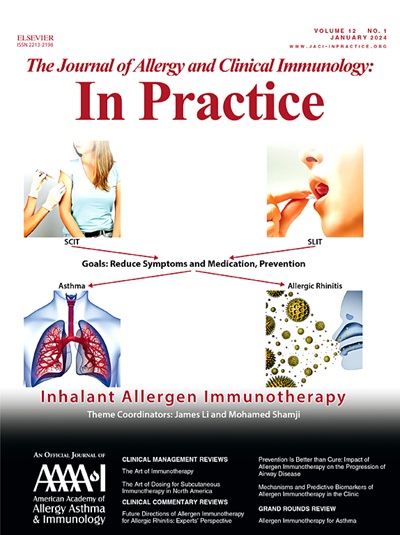Early-Life Allergen Exposure and Its Influence on Risk of Atopic Disease
IF 8.2
1区 医学
Q1 ALLERGY
Journal of Allergy and Clinical Immunology-In Practice
Pub Date : 2025-06-01
DOI:10.1016/j.jaip.2025.02.043
引用次数: 0
Abstract
Childhood allergic diseases and asthma have their origins in early life, and allergen exposures during this period could be a critical determinant of the progression to tolerance versus disease. Mechanisms for sensitization may be different but overlapping for food and aeroallergen sensitization in children. This suggests differences in how exposure to food and aeroallergens influence allergic sensitization. For food allergy, introducing foods such as peanut and egg proteins into the diet at an early age reduces the risk of peanut and egg allergy, respectively, across a broad demographic, whereas evidence is less established for other foods. The relationship between allergen exposure and sensitization to aeroallergens is more complex but critical, given the close relationship between specific immunoglobulin E and respiratory disease. Several factors could mediate the progression from allergen exposure and allergic sensitization versus tolerance, including epithelial barrier function and altered immune development at the skin and mucosal surfaces, exposure to irritants and pollutants, and genetic susceptibility. Collectively, the current evidence base provides a compelling rationale for the primary prevention of food allergy by introducing common allergens such as peanut and egg early. In contrast, primary prevention of aeroallergen sensitization is more complex and perhaps more challenging to achieve by manipulating allergen exposures. Even so, recent advances in understanding how the microbiome and environmental toxins and irritants modulate the mucosal immune response have identified potential new strategies for primary prevention of food and aeroallergen sensitization.
生命早期过敏原暴露及其对特应性疾病风险的影响。
儿童过敏性疾病和哮喘起源于生命早期,这一时期的过敏原暴露可能是耐受性与疾病进展的关键决定因素。致敏机制可能不同,但重叠的食物和空气过敏原致敏在儿童。这表明暴露于食物和空气过敏原如何影响过敏致敏的差异。对于食物过敏,在儿童早期将花生和鸡蛋蛋白质等食物引入饮食中,可以在广泛的人群中分别降低花生和鸡蛋过敏的风险,而其他食物的证据则较少。鉴于特异性IgE与呼吸道疾病之间的密切关系,过敏原暴露与空气过敏原致敏之间的关系更为复杂但至关重要。有几个因素可以介导过敏原暴露和过敏致敏与耐受性的进展,包括皮肤和粘膜表面上皮屏障功能和免疫发育的改变,暴露于刺激物和污染物,以及遗传易感性。总的来说,目前的证据基础为通过早期引入花生和鸡蛋等常见过敏原来预防食物过敏提供了一个令人信服的理由。相比之下,空气过敏原致敏的初级预防更复杂,也许通过控制过敏原暴露来实现更具有挑战性。尽管如此,最近在了解微生物组和环境毒素和刺激物如何调节粘膜免疫反应方面的进展已经确定了潜在的预防食物和空气过敏原致敏的新策略。
本文章由计算机程序翻译,如有差异,请以英文原文为准。
求助全文
约1分钟内获得全文
求助全文
来源期刊

Journal of Allergy and Clinical Immunology-In Practice
ALLERGYIMMUNOLOGY-IMMUNOLOGY
CiteScore
11.10
自引率
9.60%
发文量
683
审稿时长
50 days
期刊介绍:
JACI: In Practice is an official publication of the American Academy of Allergy, Asthma & Immunology (AAAAI). It is a companion title to The Journal of Allergy and Clinical Immunology, and it aims to provide timely clinical papers, case reports, and management recommendations to clinical allergists and other physicians dealing with allergic and immunologic diseases in their practice. The mission of JACI: In Practice is to offer valid and impactful information that supports evidence-based clinical decisions in the diagnosis and management of asthma, allergies, immunologic conditions, and related diseases.
This journal publishes articles on various conditions treated by allergist-immunologists, including food allergy, respiratory disorders (such as asthma, rhinitis, nasal polyps, sinusitis, cough, ABPA, and hypersensitivity pneumonitis), drug allergy, insect sting allergy, anaphylaxis, dermatologic disorders (such as atopic dermatitis, contact dermatitis, urticaria, angioedema, and HAE), immunodeficiency, autoinflammatory syndromes, eosinophilic disorders, and mast cell disorders.
The focus of the journal is on providing cutting-edge clinical information that practitioners can use in their everyday practice or to acquire new knowledge and skills for the benefit of their patients. However, mechanistic or translational studies without immediate or near future clinical relevance, as well as animal studies, are not within the scope of the journal.
 求助内容:
求助内容: 应助结果提醒方式:
应助结果提醒方式:


